明秋亂語
塗抹心情的地方.不施惡行,常存善念
這是講家用儲水罐的。澳洲一直缺水,政府鼓勵家家使用儲水罐,收集這難得的雨水。
Tanks very much

With summer upon us. Simon Webster investigates water tanks – from water harvesting to installation, their environmental benefits. And the new slimline versions that will squeeze in anywhere.
Good old H2O is becoming an increasingly precious resource and urban water bills are predicted to double by 2040 (according to a recent report from infrastructure Australia) so it’s just plain common sense to store water.
This is especially the case if you’re a gardener having to keep plants alive during dry times (and water restrictions). And you’ll be giving your plants the good stuff: they generally prefer rainwater to tap water, which may contain fluoride, salts and chemicals that can inhibit growth.
Plumb the tank into your house-for use in the laundry and toilet, for example-and the benefits start to multiply. As well as reducing your bills, you’ll be protecting river flows and lessening the need to build dams or desalination plants. You will also decrease stormwater runoff, and with it, the potential for flooding and the degradation of waterways.
Rainwater tanks are incredibly efficient: almost all the water that falls on your roof can be used on site (if you have enough tank capacity). When it’s bucketing down outside, it is a beautiful thing to know you’re collecting water, but a crying shame to see it flowing down the street instead.
If you think you haven’t got room for a tank, think again. There are now lots of slimline models available that will squeeze into most tight spots.
What sort of tank should I get?
There is no simple answer. It depends on what you want to use the water for, how much you use and can collect, space, budget and looks. And despite the water tank mantra of “biggest is best”, you don’t have to supply all your needs – you can just supplement mains water. In a small space, it is hugely satisfying to have even a small tank for watering pots and raised vegie beds. Every bit of water saved is definitely worth celebrating.
Bear in mind that you’re not just buying a tank, you are building a rainwater harvesting system with several elements: a roof, gutters, downpipes, a tank, a pump and plumbing.
“ You really need to think about all the components,” says Michael Smit, a committee member with Rainwater Harvesting Australia, part of the irrigation industry peak body, Irrigation Australia. ”If you can manage all of them, you’ll get good-quality water.”
Reputable tank manufacturers (get a few quotes) or a licensed plumber should be able to give you advice about choosing a tank and installation. But to start with, here are some key points to consider.
Roofs and uses
Just about any roof material – other than unsealed asbestos – is suitable for collecting rainwater if you’re only going to use it for gardening and/or indoor use such as the toilet or laundry (using a licensed plumber to plumb it into your house).
If you ‘re planning to drink the water, avoid using sections of roof containing lead flashing, asbestos sheeting or treated timbers, a chimney from a wood burner, or painted with pre1980s paint (though you can cover old paint with a potable-quality roof sealant, says yourhome.gov.au).
Roof can be contaminated by bird dropping, debris containing microorganisms, and pollution from cars and industry. Health authorities recommend, where available, only using mains water for drinking. However, millions of people in rural Australia drink rainwater every day.
Just ensure you follow guidelines to keep the water clean (first-flush devices are important) and consider further filtration between tank and home. See your local health authority website for guidelines.
How much water
How much water you can collect will basically depend on two factors the size of your roof and your local rainfall patterns. See Bureau of Meteorology website (bom.gov.au) for rainfall patterns, and bear in mind that even small roofs can be effective. For every millimetre of rain, and one square metre of roof, you should be able to collect one litre of water.
As a general guide, a four-person household with mains water and evenly spread rainfall should aim for the following water tank volumes (source: yourhome gov.au):
. Toilet flushing and use on a small garden: 2000-3000L
. Toilet flushing, clothes washing and use on a small garden: 3000-5000L
. Whole of house and garden water supply: 5000-20,000L.
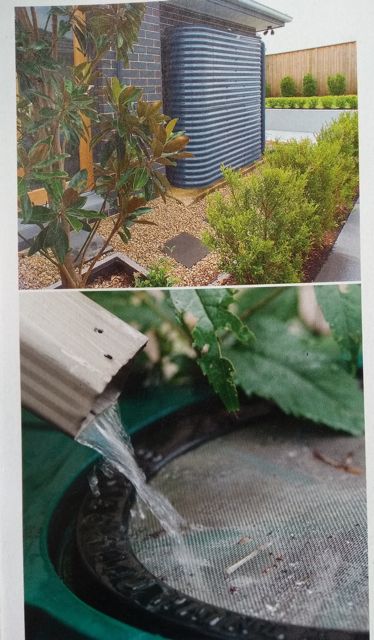
|
Tank costs A 5000L slimline tank will cost you anything from $800-$3000. Depending on the material and design, plus extras such as pumps, filters, screens, first-flush diverters and installation, plumbing and excavation, if needed. Costs can vary greatly but typically the total (including tank) will be $2000-$4500. |
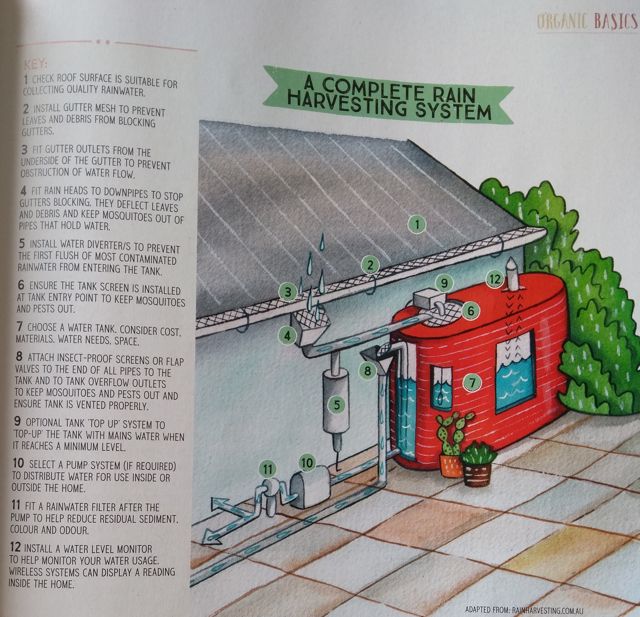
|
A complete rain harvesting system Key:
|
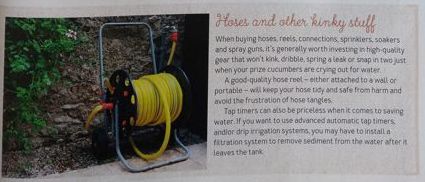
|
Hoses and other kinky stuff When buying hoses, reels, connections, sprinklers, soakers and spray guns, it’s generally worth investing in high-quality gear that won’t kink, dribble, spring a leak or snap in two just when your prize cucumbers are crying out for water. A good- quality hose reel – either attached to a wall or portable – will keep your hose tidy and safe from harm and avoid the frustration of hose tangles. Tap timers can also be priceless when it comes to saving water. If you want to use advanced automatic tap timers, and/or drip irrigation systems, you may have to install a filtration system to remove sediment from the water after it leaves the tank. |
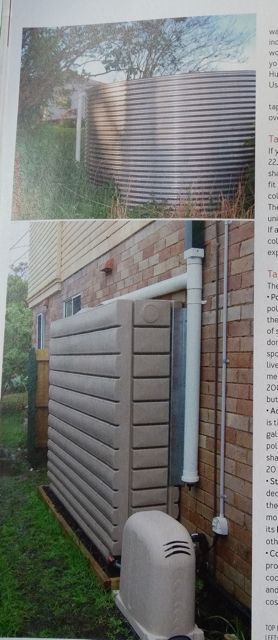
Of course, when rainfall is highly seasonal, or no mains water is available, much larger tanks are needed for water independence. To get a more specific idea of your needs, work out how much water you actually use. Look at one of your water bills and use online water calculator such as Hunter Water’s (Hunterwater.com.au/Save-Water/Water-Usage-Calculator.aspx).
To work out how much you use in your garden, attach a tap flow meter gauge to your garden tap and keep records over different seasons.
Tank size and style
If you have the space and the need, then go big with a 22,000L tank or two. But there are a wide range of sizes and shapes, right down to slimline tanks of 300 – 5000L that that fit along a fenceline or the side of the house, and in various colours so you can blend them in with their surrounds.
There are also modular systems where you link multiple units, and skinny storage walls that look like a fence.
If access to the perfect location is difficult, you can get collapsible water tanks that can be squeezed in and then expanded out when in position.
Tank materials
The most common tank materials are:
. Polyethylene. Made from food-grade, UV-treated polyethylene (generally referred to as ‘poly’ tanks), these tend to be the most affordable and come in a variety of shapes, sizes and colours. They’re light and easy to install, don’t rust, but do degrade, so locate a poly tank in a shady spot to help the UV-resistant resins last longer. And if you live in a bushfire-prone area- they melt. Make sure your tank meets Australian & New Zealand Standards ASINZS 4766:2006. Warranties last up to 25 years. Recycling is feasible, but finding a recycling facility that’ll do it is another question.
. Aquaplate. Manufactured by Bluescope Steel, Aquaplate is the most common form of steel tank. It’s a low-carbon galvanised steel with an interior lining made of food-grade polymer that prevents corrosion. Tanks come in various shapes, sizes and colours, and are guaranteed for up to 20years. They can be recycled.
. Stainless steel. Very resistant to rust, these should last for decades. Warranties can be up to 30 tears and at the end of the tank’s life, a scrap-metal dealer will generally pay good money for it. Stainless steel is easy to repair and famous for its hygienic qualities. However, it is also more expensive than other tank materials.
Concrete. A concrete tank under a driveway or yard can provide lots of storage in a small space. They keep water cool, are very durable, have warranties of up to 30 years, and can be recycled at the end of their lives. Tank installation costs, however, can be high.
.PVC bladder. Made from flexible PVC, these tanks can be in a steel frame or self-supporting. They typically come with a 10-year warranty and can be recycled.
Choose a location
Downpipe location, available space, visual appearance, and proximity to where you’re going to use the water are all factors to consider when choosing your tank location. Try to avoid direct sunlight – but also trees that lose a lot of leaves. Your tank will also need a solid base, sometimes concrete or reinforced pavers, depending on the type. A reputable tank supplier and your plumber can advise.
Keep the water clean
To avoid blockages and water contamination, you need to make sure your gutters flow towards the downpipes and keep your gutters, downpipes and tank free of debris.
Regularly cleaning out your gutters is important – especially if you have overhanging trees - and installing gutter guards and rain heads, which deflect debris away from downpipes, is an excellent idea.
So is a first-flush diverter. It will divert the first , say, 20L, of rainfall away from your tank, with the idea of keeping bird and animal droppings, dust and other contaminants, out of your water.
An inlet strainer and mesh on the tank overflow are also important to keep mozzies and other animals out. If you’re going to drink the water, it’s a really good idea to look into in-house filtration.
Get a pump
If all you want to do is fill up a watering can, putting a tap at the bottom of the tank and letting gravity do the work may be all you need.
However, in most cases a pressure pump is needed to get water from your tank to where it’s needed. A pump just for getting water for the garden rather than the whole house is likely to be cheaper.
Ask your plumber or pump supplier for advice on which pump is right for your situation and consider submersible pumps, low-noise pumps and/or a pump enclosure to keep the neighbours and council onside. Also, look into the energy-efficiency of different pumps.
Do you need a DA?
Tanks of less than 10,000L tend not to need development approval, but check with your local council just in case. Use a licensed plumber to install your tank and ensure you meet plumbing regulations.
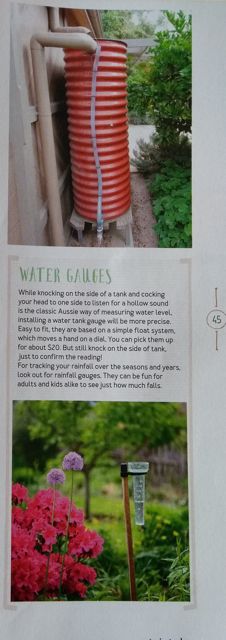
|
Water Gauges While knocking on the side of a tank and cooking your head to one side to listen for a hollow sound is the classic Aussie way of measuring water level, installing a water tank gauge will be more precise. Easy to fit, they are based on a simple float system, which moves a band on a dial. You can pick them up for about @20. But still knock on the side of tank, just to confirm the reading! For tracking your rainfall over the seasons and years, look out for rainfall gauges. They can be fun for adults and kids alike to see just how much falls.
|
文章出處: ABC Organic Gardener where naturally great ideas grow issue No. 105, Nov/Dec.2018
作者:Simon Webster





